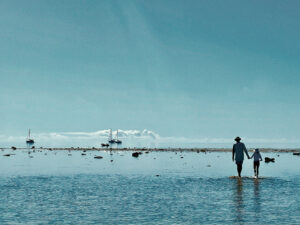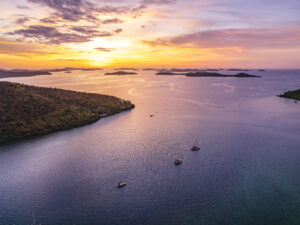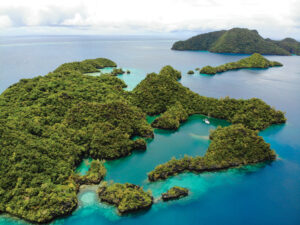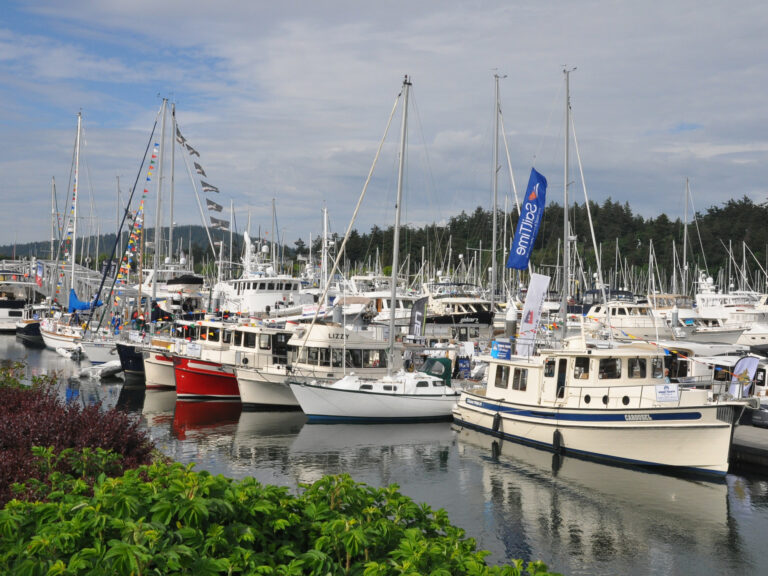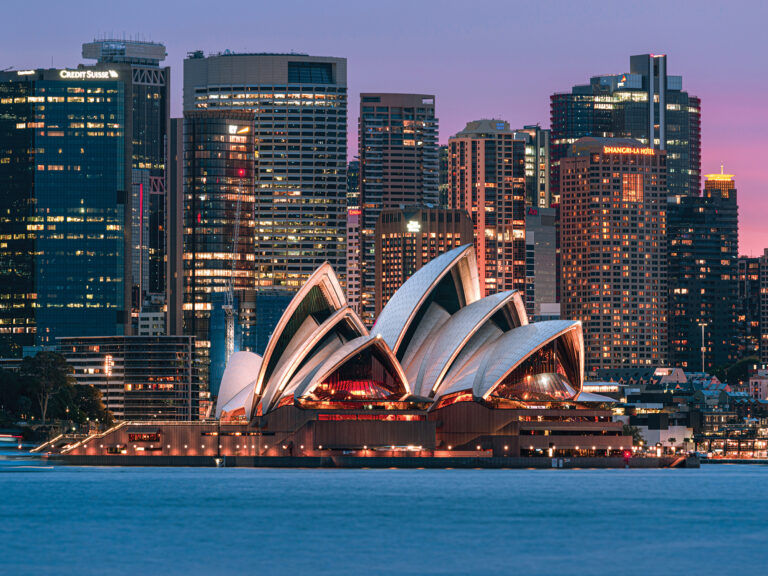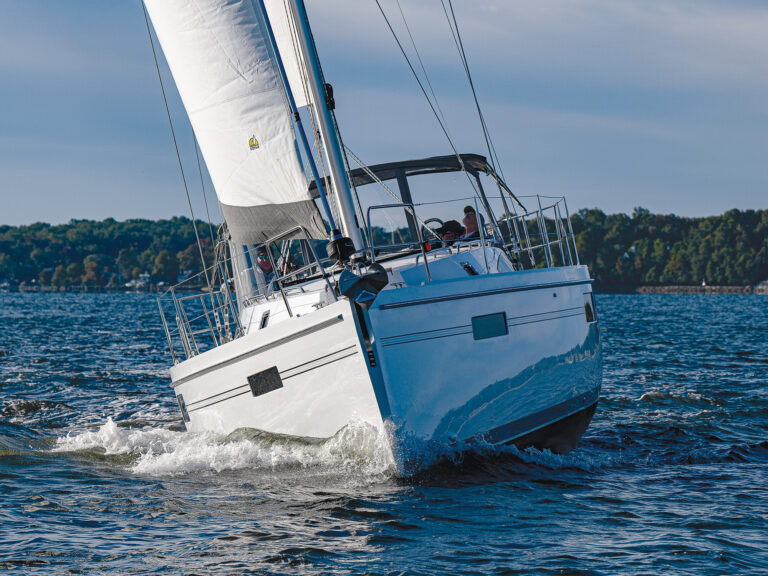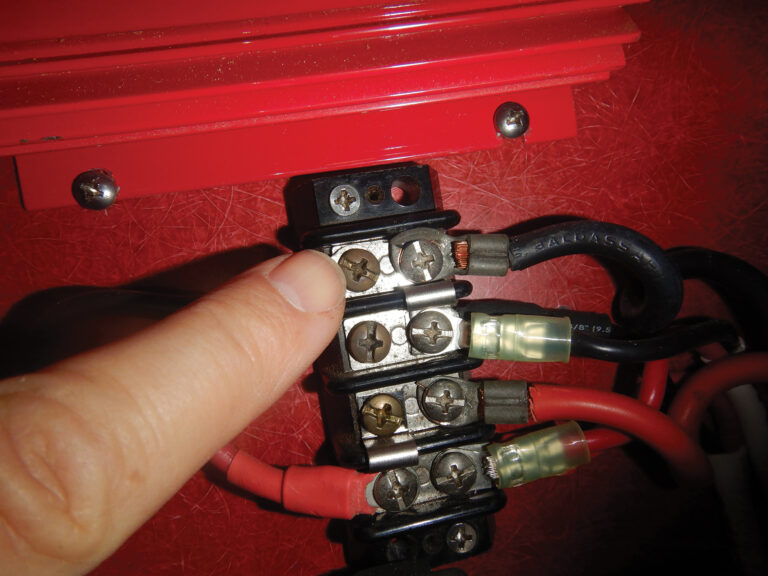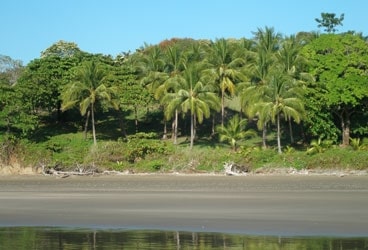
CostaRica368
Boat and Equipment
In addition to the normal requirements for any vessel traveling long distances and offshore, boats cruising to Costa Rica, if not equipped with air conditioning, need to be set up with exceptional ventilation for the comfort of the crew. That means at least two opening ports or hatches in every living space, dorades and other “waterproof” means of ventilation that can be used in tropical downpours, and fans in each cabin to increase air circulation. Lockers and other stowage areas must also be well ventilated to prevent the growth of mold and mildew.
Charts and Guides
Costa Rica has changed so rapidly in the last few years that even the newest guides contain some outdated information, particularly with respect to shore facilities. Charlie’s Charts of Costa Rica by Margo Wood is still the only guide dedicated to the country and, though dated, is invaluable for anyone planning on spending more than a few weeks there.
Cruising Ports
The Central American Route by Captain Patricia Miller Rains covers the major harbors and provides more than enough information for those passing through or cruising for a month or so. It includes accurate GPS waypoints for the harbors it covers, something our edition of Charlie’s lacked. Those heading south from Mexico who attend Sailfest in Zihuatenajo (www.zihuasailfest.com) in the beginning of February will get a copy of a CD of cruising information for Central America. A compilation of letters and reports from cruisers right up to the previous season, it provides the most up-to-date and accurate information available.
Communications
Phone calls are expensive in Costa Rica. Phone cards that can be used to call from public payphones could sometimes be purchased in the pulperias. Calls to the United States using them cost us about $1.00 per minute. By far the cheapest way to call home was via Skype or other VOIP providers. Many Internet cafes were set up with headphones but offered little privacy. Wi-fi was available in many of the restaurants and coffee shops that catered to tourists in the larger towns, and also in Los Sueños Marina near Golfo de Nicoya and Tierra Mar and Banana Bay Marina in Golfito.
Formalities
From north to south, clearance ports include the small but booming town of Playas del Coco (El Coco), Puntarenas, Jaco (in Los Sueños Marina), Quepos, and Golfito. Boats traveling within Costa Rica must obtain a cruising permit, and if they visit any of these clearance ports they are supposed to renew the permit. Boat and crew are each given 90 days in the country, which can be extended to 180 days but the renewal must be done in person.
Several nice harbors lie between El Coco and the Nigaraguan border 60 miles to the north. When boats arrive from the north, officials don’t seem to mind their making a brief stop in Bahia Santa Elena before clearing, but they are less forgiving of other stops and the area is patrolled by the Guarda Costa (Coast Guard). The harbor at El Coco is open to the Pacific swell, which builds throughout the day. On many days, by late afternoon the surf is heavy enough to overturn a dinghy unless it’s handled with care. Although it is possible to get a taxi from the more sheltered anchorages in Bahia Culebra just a few miles away, the boat must be brought to El Coco in case the Guarda Costa wishes to inspect it.
Wherever the vessel clears, the officials will want at least two copies of each document: boat documentation, passports, the clearance from the last port of call and a Spanish-language crew list (formats for this can be found in the cruising guides to the area). It’s best to arrive with copies in hand as working copy machines can be hard to come by in the smaller towns. There should be no fee for clearing in during normal business hours beyond the cost of making copies if you haven’t brought them with you.
Fuel and Water
Any boat set up with a good rain-catching system will have no need of a watermaker in Costa Rica. Fuel docks can be found in Puntarenas, Los Sueños Marina, and in Golfito. Deeper draft boats (over 6 feet) should go to the well-equipped, easy-on/easy-off dock at Los Sueños rather than trying to negotiate the shallow channel on the “backside” of Puntarenas. If you need to take on more than 100 gallons of diesel, call ahead (506-637-8886 in country) and make an appointment. Call “muelle de combustibles” on Channel 16 from the marina entrance to be sure there is space on the dock.
Getting There and Away
When coming from or going to Mexico, the biggest challenge lies in the notorious “tehuantepecers.” These gales or storms can raise up dangerous seas offshore in the Gulf of Tehuantepec, the 500-mile wide gulf at the indentation in the coast where Mexico borders Guatemala, and arise when strong northeasterlies funnel across the isthmus from the Caribbean. During the dry season, the same winds bring the strong northeasterly winds called papagayos to the northern part of Costa Rica, which can make for an upwind landfall for boats coming in from offshore. Both winds are easily forecast from conditions pertaining in the Caribbean, and you can usually get several days’ warning before they start.
To avoid getting caught in big seas or being blown way off course, many cruisers choose to keep “one foot on the beach” by sailing just a few miles offshore the entire way. Dockwise’s special float-on, float-off yacht carriers stop in Golfito a couple of times a year offering an alternative way to get there or away. On its website (www.yacht-transport.com), the company lists shipping ports and dates for the year ahead and provides a form for obtaining a quote on transporting your boat from one place to another.
Language
You will enjoy the trip much more if you learn even a smattering of Spanish. Most people don’t get serious about learning Spanish until they realize how handicapped they are trying to operate without it. If you speak little or no Spanish, make sure to bring along some self-study materials, a good dictionary and Kathy Parson’s Spanish for Cruisers (www.forcruisers.com).
Marinas
Planning permission is currently being sought for upwards of a dozen marinas in Costa Rica, but this has been the case for several years and there’s little reason to think that any new marinas will be built anytime soon. At the moment, only a few places exist to safely berth a boat and only one would be considered a real marina by international standards. The 200-berth Los Sueños Marina (www.lossuenosresort.com) is located just to the south of the Golfo de Nicoya in Bahia Herradura near the town of Jaco.
This is a full service marina/condo complex with all the amenities including a fuel dock, the only chandlery in Costa Rica geared toward offshore boats, and a luxury grocery store. Because the marina is almost filled with boats belonging to condo owners and professional fishing guides, prices for transients are very steep. We were quoted $4 per foot per day for a short-term stay.
In Puntarenas, there are several places where vessels that draw less than 7 feet can be berthed, but theft can be a significant problem. The Costa Rica Yacht Club (www.costaricayachtclub.com) offers serious and dedicated 24-hour security. Guards patrol from the water and the land, checking every boat once an hour. Several couples we know left boats there during the rainy season and had nothing stolen or damaged.
In Golfito, Banana Bay Marina (www.bananabaymarinagolfito.com) has a dozen pricey slips ($2.50 per foot per day for transients, $25 per foot per month), an American-style restaurant with American-style prices and wi-fi. Servicios Tierra Mar (Land Sea Services; marinaservices-yachtdelivery.com) has several bulletproof moorings for $8 per day and a few med-moor slips at very reasonable rates ($0.50 per foot per day, $8 per foot per month). For $4 per day, those who prefer to anchor can use the dinghy dock and the “cruisers’ clubhouse” with showers, wi-fi, satellite television, DVDs, a book exchange, and a large deck where visitors can organize barbecues.
Money and Banks
In El Coco, the only bank has no ATM. Before the bank opens, there will be a line right around the building. Customers take a number as they enter, and it can take up to six hours to actually be waited on. Most businesses in Costa Rica will accept dollars, so if you’re arriving from the north, make sure to bring dollars in a variety of small denominations to avoid having to deal with the bank in El Coco. If you have to get money in El Coco and don’t want the colorful experience of waiting in line, for about $30 roundtrip, you can take a taxi to the “Do-It Center” (that’s all you have to say to the driver) where there is a bank with an ATM that dispenses dollars or the local currency, colones. Almost all stores throughout the country, including supermarkets, accept credit or debit cards. ATMs are available in the other large towns including Puntarenas and Golfito.
Provisions
After Mexico, Costa Rica proved a real disappointment when it came to provisioning. Even basic foods are often significantly more expensive than in the US; the meat has not been aged so it tends to be tough; fruits and vegetables are refrigerated and last only days in the tropical heat. If at all possible, you should arrive with a full boat and plan to delay provisioning until you have reached your next destination-in any of the Central American countries, food will be cheaper and produce better than in Costa Rica. Thanks to the influx of rich foreigners who demand luxury goods, the north of the country offers the best provisioning and has many items that cannot be found in Central America outside of Panama-but at a price. The best supermarket is called Jumbo. It’s located in Liberia, which can be reached by an inexpensive bus ride from El Coco or by an expensive taxi ride ($50 or more roundtrip depending on your negotiating skills) from either El Coco or the resorts in Bahia Culebra. This store has just about anything you would normally find in a large US supermarket but at significantly higher prices (up to double for luxury items).
The supermarkets in El Coco are not nearly so polished, but they carry most of the same goods if you take the time to search through them, and they have excellent meat.
The supermarkets in Puntarenas and Golfito are decidedly more third world, though all the basics are available. Outside of these larger towns, provisioning will be limited to the scant offerings to be found in the pulperias. If you need to stock the boat before a Pacific crossing, arrange a visit to the Panamanian town of David for much less expensive and much more comprehensive provisioning options.
Security
As in other Central American countries, cruisers must be vigilant in Costa Rica to protect themselves and their possessions.
On our first visit ashore to clear into El Coco, our oars were stolen from our dinghy within sight of the police station. They were the only items not locked in place-after that we bought oars with holes in the blades so that we could run our security cable through them before locking it. In addition to locking the dinghy to a palm tree with a long cable, lock the outboard, fuel tank, oars and dinghy tires securely to the dinghy. At night, lift the dinghy from the water on a halyard and lock it to the toerail or to the boat’s rigging.
If you leave the boat unattended, close it up completely and lock it. We heard several stories of young kids swimming out to boats and getting through portholes to steal small items like cameras.
When ashore, take the normal precautions: Don’t wear flashy jewelry, don’t carry much money, and so on. If traveling inland, do not let your backpack leave your hands. In a scam that’s common on the buses, someone offers to stow your backpack for you and it gets passed backward to an accomplice who jumps off the bus with it. That said, we had nothing stolen but our oars, and while we heard many stories from visitors and locals alike, none of the other cruisers we met had anything stolen either.
Sightseeing
Some of Costa Rica’s most fantastic sights are inland: cloud forests, volcanoes, mountain villages, lush jungle valleys, and elusive wildlife like the exotic Resplendent Quetzal. For those wishing to do some touring, the marinas mentioned above are the only safe places to leave the boat for more than an overnight. Car rentals, buses, and organized tours are available from any of these places. For those wishing to see some of Costa Rica’s abundant wildlife in day trips from the boat, the best options are Bahia Santa Elena in the heart of Parque Naçional Santa Rosa in the north and Bahia Drake, which offers hiking or motorboat access to the Osa Peninsula and the Parque Naçional Corcavado in the south. Boats can also anchor right in Parque Naçional Manuel Antonio just to the south of Quepos, but only in calm periods when the swell is minimal. Those spending time in Golfito should not miss Casa Orquideas (Orchid House) and its breathtaking gardens filled with dozens of species of orchids as well as an astonishing variety of birds and butterflies.
Yacht Services and Chandleries
Various marine stores in El Coco, Puntarenas, and Golfito cater to the local fishing boats, and some basic spares and materials can be found in these. Very little exists in the way of specialized yacht spares. The chandlery at Los Sueños Marina has some parts for watermakers, generators and other equipment. Parts can be shipped from the States via DHL to their offices in Liberia (the office in El Coco closed when we were there but was supposed to reopen within a few months) or Puntarenas, or, by special arrangement, to one of the marinas in Golfito. We were not charged duty or VAT on a fluxgate compass we had shipped in to the country, although we were charged a $22 inspection fee by customs.
Weather Forecasts
Little in the way of weather information is available for this coast, but there’s little need much of the time. Don Anderson on Summer Passage reports weather from California south to Panama and across the eastern Pacific, and he includes mention of the papagayo winds when they are forecast to blow. Updated times and frequencies can be found at his website (www.csus.edu/indiv/f/foxs/Summer%20Passage/sumpas_index1.html).
The Northwest Caribbean Net (www.nwcaribbean.net/index.html), which operates on 6209 kHz and 6212 kHz at 1400 UTC, provides forecasts for the western Caribbean and will give cruisers a heads up if the strong northerly winds are developing that will eventually result in papagayos. For most of our stay, we relied on regular GRIB downloads, and these gave us several days’ warning of upcoming papagayo winds.

